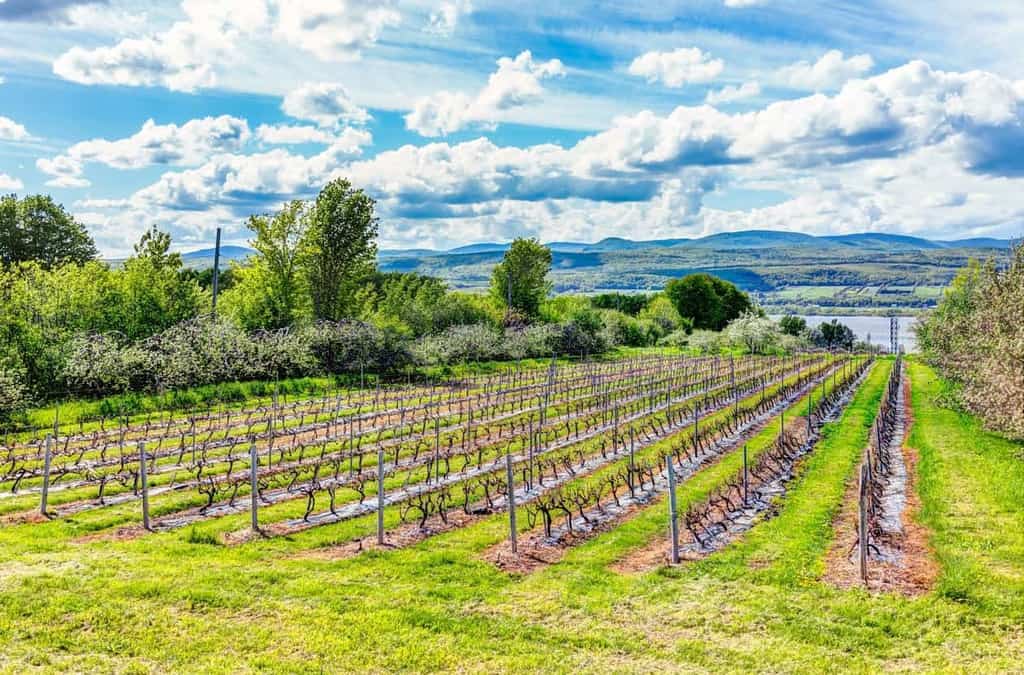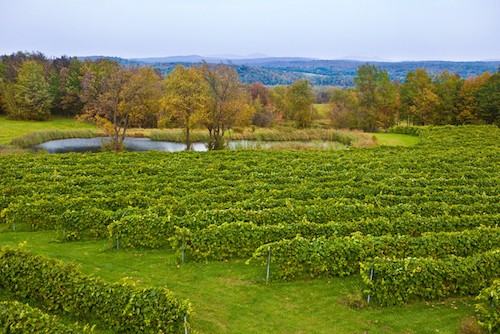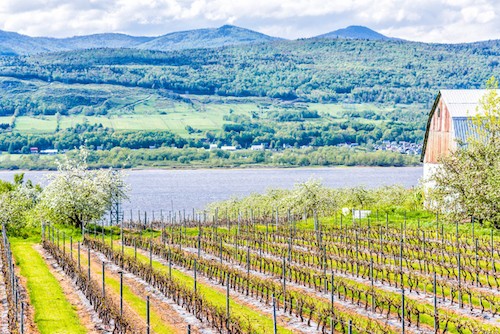Je Me Souviens, or I remember. Embossed on every Québec license plate, it’s an appropriate official motto for la belle province. Wine culture here is infused with an adventurous spirit unlike anywhere else in Canada and few new world winegrowers have faced such challenges to their success, from lobbying government to allow the legal sale of their wares to facing extreme climate conditions. Québec’s wineries are at a unique place in development and prime for exploration.
Before we begin the wine journey started by early 17th century French colonists we should look to who came before. Like the rest of Canada, the first settlers to Québec were First Nations peoples: earliest documented are the Iroquois followed by many others, including the Abenaki and the Montagnais. Many of the winegrowing areas are still home to the descendants of these Indigenous peoples.
RELATED: An Overview of Canada’s Various Wine Regions
Quebec’s History
There’s a long history to winemaking in Québec dating back to 1535 with Samuel de Champlain planting vinifera, albeit unsuccessfully. Commercially the region is young, but winemakers here have been slightly ahead of their time. The Société des Alcools du Québec (SAQ) was founded in 1921, but until 1985 it was illegal for Québec producers to sell their wines. Those in the industry operated illegally and somewhat tenuously before winemakers could finally get permits through the SAQ.
Organizations
Unlike other provinces in Canada, Québec has no single point of wine tourism. Agri-tourism is the larger umbrella and includes wine, beer, spirits, restaurants, and cheesemakers, along with other producers. It’s a cornucopia of taste partly due to the geography; with only one major ‘wine route’ and often many kilometers or miles between vignobles, it’s attractive to package the offerings together.
Québec has more than one group that represents growers and winemakers. There’s Vins du Québec, the Québec Winegrowers Association, first established in 1987 as a way for winemakers to pool resources to develop their young wine industry. The association now has 71 wineries growing 20 different grapes on 417 hectares with 144 ‘vins certifiés’ as Québec Certified Wines.
RELATED: How To Explore Canada’s Beautiful British Columbia
Additionally, the Vignerons Indépendent du Québec was established in 2006 by winemakers. Their mandate includes facilitation and promotion of the sale of Québec wine products, research, and representing the industry at the government level. The group has 55 members and as of 2011 joined the European Confederation of Independent Vintners. Other provincial tourism organizations and groups also intermingle wine touring information with their agri-tourism siblings.
Climate & Soil
The province has a humid continental climate with fertile agricultural land in the southern portion where the major growing regions are. Tree fruits and ground crops grow with little risk of damage from low temperatures, but grapes are another matter. Long winters and humidity make grape growing a challenge; the St. Lawrence River moderates, but extended periods of cold are a real threat. Growers use various techniques to help prevent damage, from burying vines to geo-tech fabrics. It can get expensive, fast, and requires serious attention to detail.
Growing Areas
The province has +370 hectares of vines producing +2,500 tons of grapes and that’s
small for a province this size. There are no real ‘wine routes’ here per se, save one: the Eastern Townships. Located in the southeastern part of the province, this region represents approximately 60% of the Québec’s wineries and is the birthplace of regional viticulture. The Brome-Missisquoi’s Wine Route is around 140kms or 86mi long with +25 vineyards.
In the southwest is Montérégie, a combination of urban and rural with an integrated agricultural base heavily supported by tourism. Québec’s other growing regions include the Basses Laurentides (lower Laurentians), Lanaudière northeast of Montreal between the Saint Lawrence River and the Laurentians, and the larger encompassing Centre-du-Québec outside of Montreal and Québec City that has a handful of wineries.
Ask An Expert
With so much movement and, well, newness to Québec’s wine industry, it’s best to ask an expert. Enter journalist and writer Rémy Charest. Based in Québec City, Charest has been writing about wine and food since 1997 and knows his way around the province’s vineyards. Lucky for us, he’s also a friend.
“There are always phases in emerging wine regions,” says Charest. Beginning with ‘hey, we can ripen grapes here’ and progressing to ‘oh, we can make wine’, a natural next step is to evaluate what you’re trying to accomplish and why. “There’s more clarity now to the approach, and it’s more often approached as a business.”
RELATED: Learn About Canada’s Nova Scotia Wine Country
Where early winemakers might have started smaller retirement or personal projects that grew into something more, those entering this industry in the last decade are doing so with a clearer intention. It’s showing in vineyard management and becoming evident in the wines they’re producing.
The typical vignoble here makes hundreds of cases per year, not thousands. Supply is short and if you find a favorite it’s best to snag it while you can. The provincial monopoly (SAQ) retails more of the region’s wines than it has in past years but a commitment to sell in this channel means less is available in other channels, even at the cellar door.
Growers and winemakers are seeing success with both vinifera and hybrid varieties, and with maturity they’re beginning to see the grapes require different approaches despite what their original intention with them might have been. “There’s no line of definition you can give Québec wines,” explains Charest. Where Ontario’s newest region, Prince Edward County, can hang its hat on Chardonnay and Pinot Noir, there is no equivalent defining anything in Québec. Yet as with any newer wine growing area, the regions are gaining a clearer sense of what they can do.
RELATED: How To Explore Ontario’s Wine Country
Like its adventurous history, winemaking in Québec continues to push these tender new boundaries. There’s an organic and natural wine movement from vineyard to cellar and words like ‘skin contact white wine’ can be heard with more frequency; not everywhere, but more than one might think. It’s wine-geek paradise for those seeking an unexplored frontier in new world wine.
Be open, ask questions, and try absolutely everything.
What To Drink
With help from our local insider, here are some interesting wines to seek out in la belle province. (thanks for the tips, Rémy)
- Classic: Vignoble Camy, Chardonnay, south Montérégie
- Adventurous: Domaine de Bergeville, all sparkling, Eastern Townships
- Exploratory: Domaine du Nival, Gamaret (and all organic wines), Lanaudière
- Natural wines: Pinard et Filles, Eastern Townships
- Organic Wines: Vignoble Les Pervenches, particularly the Chardonnay, Eastern Townships
- Other Interesting Wineries: Domaine du Fleuve, Montérégie
Where to Stay
If you’re exploring the Eastern Townships take advantage of it and stay in one of many quaint country inns or B&Bs. They’re everywhere. And while the other regions have fewer wineries it’s worth dedicating a night to fully experience the area for all the agri-tourism offers. Alternatively, stay in Montreal or Québec City and take a couple of day trips to different wineries – er, vignobles – and get the best of both worlds.
Where to Eat
Same as above. Eat all the cheese (there’s SO much good cheese), chocolate, duck, local meats. Try breakfast or lunch at a café de village and if you can’t pronounce something in French try politely pointing to the dish, remember to smile, and be sure to tip well.



Looking for a plan to travel the eastern areas of Montreal-Quebec. B&B, travel plan. How much time to allow. Thank you.